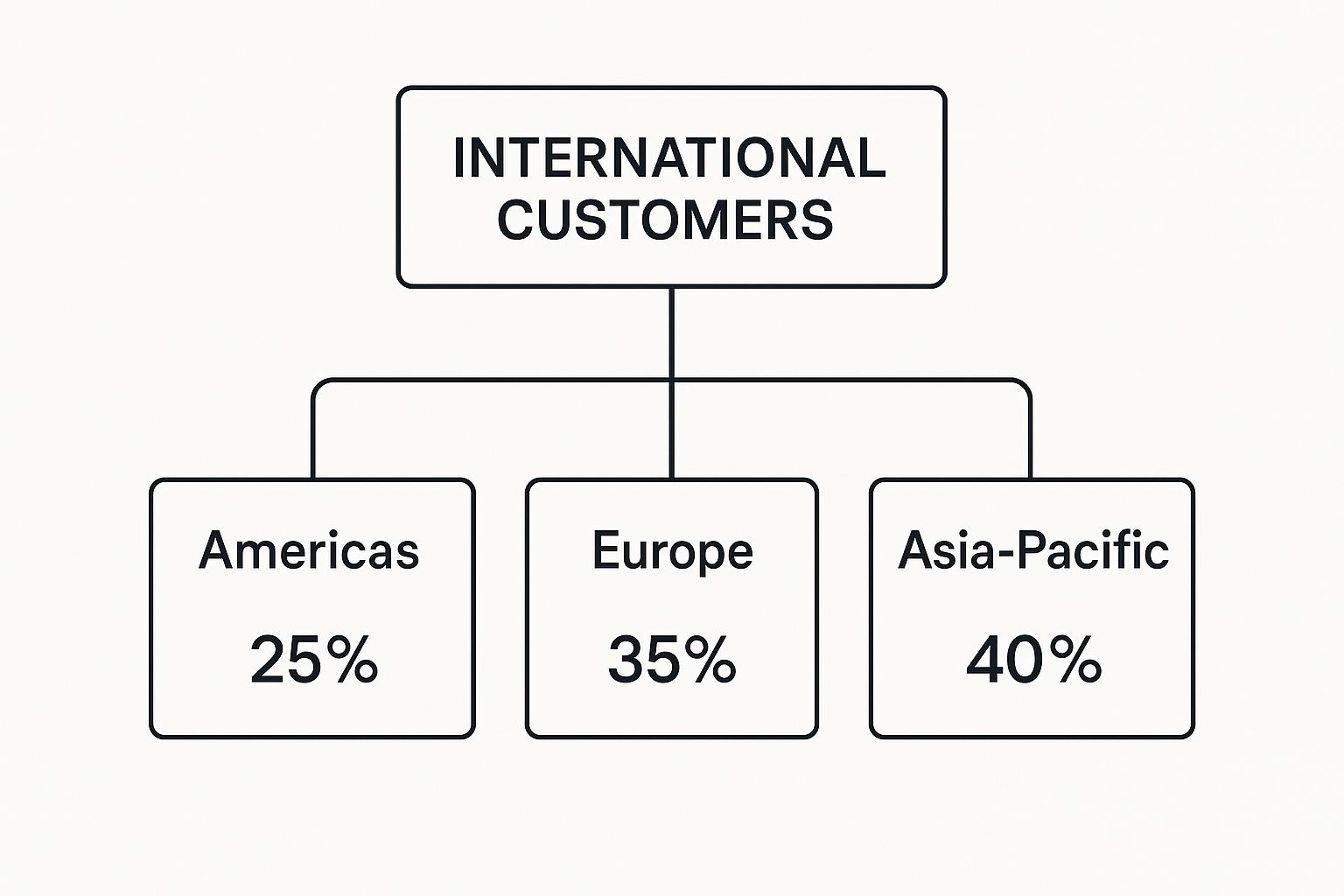Think of an international customer as anyone who buys your products or services from outside your company’s home country. Not too long ago, chasing this audience felt like a luxury reserved for massive corporations. Today, it’s a core growth strategy for businesses of all sizes trying to make their mark.
The Untapped Opportunity in Going Global
Imagine your business moving from a quiet local street to a bustling global marketplace. That’s the power of attracting international customers. The rise of e-commerce has torn down the old barriers, opening up a huge new audience for anyone willing to think beyond their own zip code.
The scale of this opportunity is staggering. The global e-commerce market is projected to hit $4.8 trillion by 2025, and that growth is being fueled by cross-border sales to a pool of over 2.71 billion online shoppers. This isn’t just a trend; it’s a fundamental shift that makes a global customer base essential for long-term survival and growth.
Of course, reaching this market means having a solid game plan. Understanding effective customer acquisition strategies is the first step to turning all that potential into actual revenue.
Reaching international customers transforms your business from a regional player into a global brand. It diversifies risk, accelerates growth, and unlocks invaluable market insights that fuel innovation.
So, where in the world are all these shoppers? This quick breakdown shows the primary regions driving online sales.

As you can see, the Asia-Pacific region represents the single largest slice of the global market, making it a critical area to watch for any business looking to expand its footprint.
Strategic Benefits of a Global Customer Base

Tapping into an international customer base isn’t just about boosting sales numbers—it’s a core strategy for building a more resilient, forward-thinking business. When you open up to a global market, you diversify your revenue streams, which makes your entire company less exposed to economic hiccups in any single country.
Think of it like having multiple anchors in different harbors. If a storm hits one, the others keep your ship steady. This kind of economic resilience provides a solid foundation for growth, freeing you from the unpredictable tides of one local economy.
Fueling Growth and Innovation
Beyond pure financial stability, a diverse, international audience becomes a direct pipeline for priceless market feedback. What captures the attention of buyers in Tokyo might be totally different from what excites shoppers in Berlin, and those little insights can spark product improvements you would have never dreamed up otherwise.
This feedback loop puts your innovation cycle into overdrive. A feature that your French customers are clamoring for might just become a massive hit with your audience in Brazil. It’s this cross-pollination of ideas that keeps your products fresh and globally competitive.
Serving a global customer base turns your business into a learning machine. Each new market provides unique data points that sharpen your products, refine your marketing, and ultimately make your entire operation smarter and more adaptable.
This global perspective naturally bleeds into your internal team, too. Managing customers worldwide often means you need a diverse workforce to match. You can dive deeper into the advantages of building a team with experience managing international employees in our related guide. When you embrace a global mindset—both with your customers and your team—you unlock a powerful combination for lasting success.
Navigating Common Cross-Border Challenges

While the idea of a global customer base is exciting, the path to get there is dotted with some very real obstacles. It’s about more than just translating your homepage; you have to wrestle with logistical, financial, and cultural puzzles to make the entire customer journey feel effortless.
Think of it like being an expert tour guide in a city you’ve never visited. To give people a five-star experience, you’d need to speak the language, handle the local currency, and know the transit system like the back of your hand. It’s the same for your business—you need to master these areas to win over a global audience.
Financial and Logistical Hurdles
One of the first brick walls you’ll run into is payments. It sounds simple, but international customers expect to pay in their own currency using methods they trust, which can be a real headache to set up. High conversion fees, painfully slow bank transfers, and mysteriously declined cards are the kinds of friction that can stop a sale dead in its tracks.
The diagram above shows how a payment gateway works as that crucial middleman, securely linking your business to different payment networks all over the world. It’s the engine doing the heavy lifting on those complex cross-border transactions, making it possible for you to get paid from anywhere.
Then there’s the whole logistics puzzle. Juggling international shipping, customs forms, and a dizzying array of tax laws requires some serious planning. One small mistake can lead to frustrating delays or surprise fees for your customers, quickly souring their view of your brand.
“Successfully serving international customers means solving their problems before they even notice them. Seamless payments and predictable shipping aren’t just features—they are fundamental requirements for building global trust.”
Language and Cultural Barriers
Beyond the nuts and bolts of moving money and products, you have to nail the human element. A marketing campaign that resonates in one country could completely miss the mark—or worse, be offensive—in another. It’s no surprise that 76% of online shoppers would rather buy from sites that give them information in their own language.
To handle this well, you need a solid strategy for integrating all your customer data from different regions. You can dig into the essentials of getting that right by checking out these data integration best practices. And if you’re looking for ways to cut through the payment complexity, using crypto payments for business to achieve global reach and lower cross-border fees can be a clever way to sidestep a lot of traditional banking headaches.
How to Build a Powerful Localization Strategy
To really click with international customers, you have to go beyond simple translation and embrace localization.
Think of your business like a cultural chameleon. It’s not enough to just speak the language; you need to adapt your colors and behaviors to blend in and feel like a natural part of the scenery. Localization is all about making your entire brand feel like it was born and raised in every market you enter.
This is much deeper than just swapping out words. We’re talking about changing your website’s imagery, tweaking marketing messages, and sometimes even adjusting your products to fit local customs. For example, a color that screams “celebration” in one culture might signify mourning in another. Getting these details right is the difference between connecting with your audience and completely missing the mark.
Research and Prioritization
Before you jump in, you have to do your homework. Get to know the local environment through deep market research. You’ll need to uncover cultural nuances, figure out how people prefer to pay for things, and see what the competition is up to. Whatever you do, don’t try to be everywhere at once. Pick the markets that have the best shot at a solid return on your investment and start there.
A huge piece of this research is understanding how people shop locally. The trend is clear: consumers worldwide are increasingly drawn to local brands. In fact, 47% of consumers globally say that supporting locally owned companies is important to them. This preference shapes everything from beauty product sales in China to snack choices in Japan. You can read the full analysis on global consumer behavior on mckinsey.com.
Localization is the art of making your global brand feel like a local favorite. It’s about building trust by showing your international customers that you understand and respect their culture.
Executing Your Strategy
Once you’ve picked your target markets, the real work begins. This is where you start adapting your brand, and it’s usually more involved than a simple find-and-replace on your website.
Here are the core areas to nail down:
- Website and Content: Make sure all your text, images, and user interface elements are culturally on point. This includes simple things like using the correct date formats, currencies, and units of measurement.
- Payment and Logistics: Offer payment methods that people in the region know and trust. Your shipping options need to be clear, reliable, and priced competitively for that specific market.
- Marketing and Communication: Don’t just translate your ads. Tailor your campaigns and social media to reflect local values, holidays, and events. A one-size-fits-all marketing strategy almost never works across borders.
Pulling all of this off requires a solid game plan. If you’re building out a multilingual presence from the ground up, getting the fundamentals right is key. For some practical tips, check out our guide on how to properly implement a multi-language strategy.
Meeting Modern International Customer Expectations

Today’s international shoppers are savvier than ever before. They’re looking for experiences that feel like they were made just for them—prioritizing quality and unique value over the same old mass-market stuff.
This means just having a presence in another country isn’t enough anymore. You have to genuinely connect with the local mindset. It’s one thing to know how to localize, but it’s crucial to understand why. International customers want to feel seen and understood. That means transparent pricing in their currency, service that doesn’t waste their time, and products that actually fit their needs.
Personalization And Value Driven Choices
The hunger for custom-tailored experiences is a huge driver in global commerce. In fact, a whopping 51% of consumers now say they want products that fit their specific lifestyle. At the same time, with 72% of people worried about rising costs, getting real value for their money is paramount.
That puts the ball squarely in our court: we have to deliver personalized value. To hit both of these marks, it’s worth digging into strategies to improve overall customer experience, making sure every single touchpoint feels relevant and worthwhile.
“The modern international customer doesn’t just buy a product; they invest in an experience. They expect you to know who they are, what they need, and to deliver it with minimal friction.”
Nailing these expectations really boils down to crystal-clear communication. A massive part of that is speaking your customer’s language, fluently, no matter how they reach out. For any business trying to grow its global support, looking into tools for providing multilingual customer service can be a total game-changer. It’s how you build the trust and loyalty that keep global buyers coming back.
Creating a World-Class Global Support System
Excellent support is your secret weapon for turning international customers into lifelong fans. But when your customers are scattered all over the globe, “excellent” takes on a new meaning.
Building a system that feels local everywhere means tackling two major hurdles head-on: time zones and language barriers. The real goal is to offer help that feels instant and effortless, no matter where someone is or what language they speak.
This doesn’t mean you need a physical office in every country. A smart mix of strategies can create a seamless experience. The key is to make your support accessible on your customers’ terms, not yours. When help is easy to find and understand, you build trust right from the start.
Blending Human and AI Support
A really effective approach combines your trusted human agents with AI-powered tools. Think about live chat and email—real-time translation can empower your existing team to handle inquiries in dozens of languages. Suddenly, your reach expands massively without the crippling cost of hiring a huge multilingual team.
Beyond direct communication, self-service is your best friend. A well-organized, translated knowledge base or FAQ section lets customers find answers on their own schedule. This is a game-changer for serving different time zones, giving you 24/7 support without needing round-the-clock staffing.
The best global support systems feel invisible. Customers get fast, accurate answers in their own language, without ever having to think about the complex operations running in the background.
Building a Scalable Framework
As your business grows, your support system has to keep pace. This means creating processes that can handle more tickets from new regions without breaking a sweat.
A well-structured system lets you manage everything from a central hub, which is far more efficient. You can dive deeper into establishing this kind of solid foundation in our guide on setting up a global IT service desk. By investing in the right tools and strategies now, you’re not just solving problems—you’re building loyalty that generates positive word-of-mouth worldwide.
A Few Common Questions
Thinking about taking your business global? It’s a big move, and it naturally brings up a lot of questions. Here are some straightforward answers to the things leaders and teams usually ask when they start mapping out their international strategy.
What’s the First Step to Attract International Customers?
The first, most critical step is market research. Before you even think about marketing spend or website tweaks, you need to figure out which countries hold the most promise for what you sell.
Look for places where there’s clear demand but the hurdles to get in aren’t impossibly high. Get to know the local competition, the cultural quirks, and how people prefer to pay for things. Doing this homework upfront saves you from making expensive guesses and helps you point your resources where they’ll actually make a difference. It’s always better to be a sniper than to spray and pray.
Do I Need a Separate Website for Each Country?
Not usually, but you absolutely have to focus on localization. While the giant multinational corporations might spin up unique, country-specific domains, most businesses can win by simply localizing their main site.
And localization is way more than just translating the words on the page. To do it right, you need to:
- Show prices in the local currency.
- Offer payment methods people in that country know and trust.
- Adjust your photos and marketing copy so they resonate culturally.
- Use the right formats for dates and measurements.
The whole point is to make customers from anywhere feel like you built the site just for them.
If there’s one thing that makes or breaks the international customer experience, it’s clear communication. If a customer can’t understand your product details or get help in their own language, they’re gone. In fact, 73% of customers are more likely to buy from a site that gives them information in their language.
How Can I Offer Multilingual Support Without Breaking the Bank?
Hiring a huge team of agents fluent in every possible language just isn’t realistic for most companies. The smartest, most efficient path is to blend your current support team with AI-powered translation tools.
These tools plug right into your help desk or chat software, letting your agents communicate flawlessly across dozens of languages. This gives you instant, 24/7 language coverage without the massive overhead. It completely changes the game for your international customers and makes your team incredibly efficient. Once you solve the language problem, you’ve removed one of the biggest roadblocks in the global customer journey.
Ready to knock down language barriers and deliver amazing support to customers anywhere in the world? resolution Reichert Network Solutions GmbH‘s Issue Translation for JSM brings AI-powered, real-time translation right into your Jira Service Management workflow. Start your free trial today and turn your service desk into a global support powerhouse. Learn more and get started for free on the Atlassian Marketplace.
